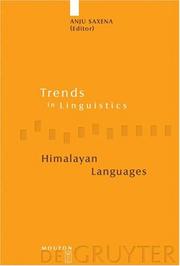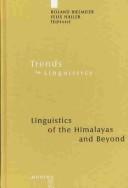Union Catalogue of Belgian Libraries
Narrow your search
| Listing 1 - 4 of 4 |
Sort by
|
Book
Negation: a cross-lingusitic study
 Loading...
Loading...
Author: Honda, Isao
Year: 1996 Publisher: Buffalo, N.Y. University of New York
Year: 1996 Publisher: Buffalo, N.Y. University of New York
Abstract | Keywords | Export | Availability | Bookmark
 Loading...
Loading...
Export citation
Choose an application
- Reference Manager
- EndNote
- RefWorks (Direct export to RefWorks)
Bookmark
Abstract
Keywords
Digital
Trans-Himalayan Linguistics : Historical and Descriptive Linguistics of the Himalayan Area
 Loading...
Loading...
Authors:
Blench, Roger
---
Bodt, Tim
---
DeLancey, Scott
---
Driem, George van
---
Hill, Nathan W.
---
et al.
ISBN: 9783110310832 9783110310740 Year: 2013 Publisher: Berlin ;; Boston De Gruyter Mouton

ISBN: 9783110310832 9783110310740 Year: 2013 Publisher: Berlin ;; Boston De Gruyter Mouton
Abstract | Keywords | Export | Availability | Bookmark
 Loading...
Loading...
Export citation
Choose an application
- Reference Manager
- EndNote
- RefWorks (Direct export to RefWorks)
Bookmark
Abstract
Keywords

Himalayan Languages : Past and Present
 Loading...
Loading...
Authors:
Andvik, Erik
---
Bickel, Balthasar
---
Bielmeier, Roland
---
Grunow-Hårsta, Karen
---
Gvozdanović, Jadranka
---
et al.
ISBN: 9783110898873 9783110178418 Year: 2011 Publisher: Berlin ;; Boston De Gruyter Mouton

ISBN: 9783110898873 9783110178418 Year: 2011 Publisher: Berlin ;; Boston De Gruyter Mouton
Abstract | Keywords | Export | Availability | Bookmark
 Loading...
Loading...
Export citation
Choose an application
- Reference Manager
- EndNote
- RefWorks (Direct export to RefWorks)
Bookmark
Abstract
Keywords

Linguistics of the Himalayas and Beyond
 Loading...
Loading...
Authors:
Bielmeier, Roland
---
Borchers, Dörte
---
Caplow, Nancy J.
---
Denwood, Philip
---
Devi, Thokchom Sarju
---
et al.
ISBN: 9783110968996 9783110198287 Year: 2011 Publisher: Berlin ;; Boston De Gruyter Mouton

ISBN: 9783110968996 9783110198287 Year: 2011 Publisher: Berlin ;; Boston De Gruyter Mouton
Abstract | Keywords | Export | Availability | Bookmark
 Loading...
Loading...
Export citation
Choose an application
- Reference Manager
- EndNote
- RefWorks (Direct export to RefWorks)
Bookmark
Abstract
Keywords
| Listing 1 - 4 of 4 |
Sort by
|

 Search
Search Feedback
Feedback About UniCat
About UniCat  Help
Help News
News